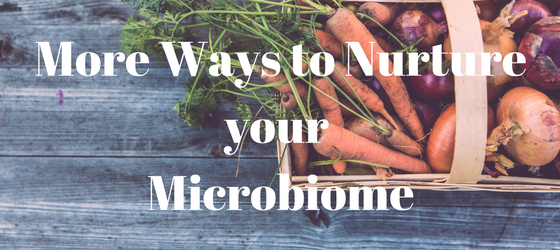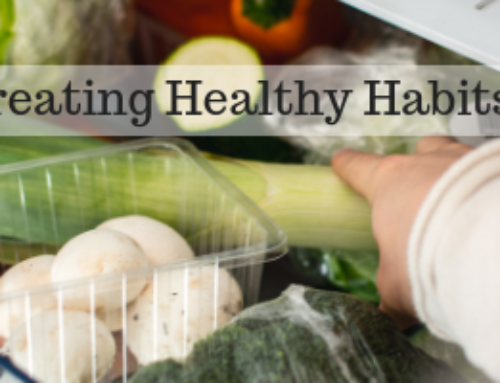In my last post, I spoke about the importance of hitting a daily fiber goal of at least 30 grams per day, ideally 50, to nurture your gut microbiome – those good bacteria that live in your gut. Fiber is the non-digestible part of plant foods, and high fiber foods include vegetables, beans, and berries, among others. Your microbiome loves fiber. While adopting a diet high in fiber is one of the most important things you can do to support your microbiome, there are other habits that can provide additional benefit. Let’s take a closer look at what else you can do to keep your gut happy.
Eat fermented foods – Long before refrigeration took hold, which has only been for about the last one hundred years, humans had to find ways to preserve their food for future use. Fermentation or more specifically, lacto-fermentation, was crucial for this and has been a traditional way of preserving food for millennia. Fermentation is a process by which bacteria feed on the carbohydrate or sugar in a food, and produce alcohol or lactic acid, with carbon dioxide as a by-product. The process of fermentation is beneficial because it helps to “pre-digest” the food basically breaking down sugars, releasing amino acids and vitamins, thereby making these nutrients more accessible to digestion and absorption. The good bacteria also thrive in these conditions, and thus multiply. When these foods are eaten, they provide a source of beneficial bacteria to the gut.
There has been a resurgence of interest in fermented foods in recent years, from home cooks to food producers. Some of the more common fermented foods you can add to your diet to benefit your microbiome include:
Yogurt – make sure to choose plain yogurt without added sugar.
Kefir — choose plain kefir without added sugar — find in the dairy section.
Sauerkraut – the lacto-fermented kind; again find it in refrigerated section. Not the pasteurized kind you find on the inner shelves – this type has had all the good bacteria killed through heat. Firefly Kitchens is a local Seattle company that makes a variety of sauerkrauts that you can purchase at some grocery stores as well as farmer’s markets. Check out their class Fermentation 101 where they teach you to make your own sauerkraut and kimchi.
Kimchi – a traditional Korean vegetable ferment flavored with red pepper seasoning.
Pickles – again, look for the lacto-fermented kind in the refrigerated section. Britt’s Pickles is a local Seattle company that makes this kind of pickle, which you can find at the Pike Place Market and some local grocery stores. Check out this short video of Britt himself being interviewed by Evening Magazine on the health benefits of lacto-fermented vegetables.
Take a probiotic – Probiotics are the live microorganisms that live in and on our bodies and may be able to help prevent and treat some illnesses. Two of the most common good bacteria that live in the gut are acidophilus and bifidobacterium. Promoting a healthy digestive tract and a healthy immune system are their most widely studied benefits. Within the gastrointestinal tract, probiotics play a number of functional roles, including maintaining the intestinal barrier integrity, regulating mucin secretion, and controlling immunoglobulin A secretion. While these beneficial bacteria are found in fermented foods, probiotics in supplemental form provide therapeutic doses of beneficial bacteria. Individuals coming off antibiotic therapies, as well as those with colitis, candidiasis, and other GI conditions can greatly benefit from taking a supplement to ensure a repletion of beneficial bacteria on a daily basis. I often suggest Probiotic Supreme from Designs for Health to my clients in need of this kind of support.
Avoid artificial sweeteners — Introduced over a century ago, these agents were designed to enhance taste and stimulate sweet reception on the tongue without the effects of caloric intake, theoretically benefiting weight loss. However, recent evidence indicates that these artificial sweeteners drive the development of glucose intolerance through inducing compositional changes to the intestinal microbiota. Interestingly, by way of altering the gut microbiome, artificial sweeteners may be contributing to the very obesity epidemic they were intended to combat.
Sleep – Did you know the gastrointestinal tract and the microbiome operate on a 24-hour circadian schedule? This schedule helps prepare for the GI for the changes in the physical environment associated with day and night. The microbiome follows the same circadian rhythm and influences sleep homeostasis. I find this pretty amazing — that the microbes in our gut need a rest too. These circadian rhythms regulate a number of GI functions, including gastric acid production and colonic motility. The physical rhythms of the gut in turn regulate and influence the health of the microbiome. It has been shown that prolonged sleep disruption and the accompanying stress response will invoke proinflammatory markers in the gut, which result in a low-grade chronic inflammatory state. Lastly, the gut produces upwards of 95% of our body’s serotonin, the neurotransmitter that influences mood and healthy sleep patterns. So, maintaining a healthy gut with a diet high in fiber, fermented foods, and probiotics will also impact your brain health and mood.
There you go, more ways to nurture your gut microbiome, and uplevel your health. I hope you found this information helpful, and take away just one healthful tid-bit to put in place today.
As always, if you enjoyed this blog post, please share with family or friends.






